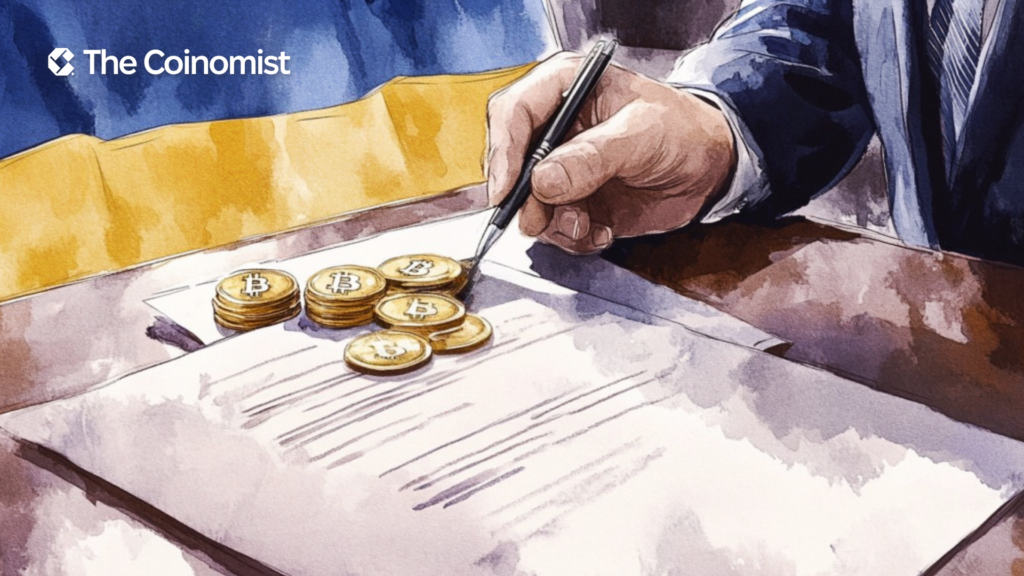Ukraine’s 2024 Declarations Spotlight Crypto as a New Norm

2,100 Ukrainian officials, from police officers to MPs, declared crypto in 2024. BTC, USDT, and ETH are becoming standard lines in the public-sector financial life.
On this page
In Ukraine, there is a curious transformation taking place—not in parliament halls or on trading floors, but in the quiet bureaucratic ritual of filling out an annual declaration. The once mundane exercise of listing real estate, cars, and savings now has a new star: cryptocurrency.
Over 2,100 Ukrainian officials declared crypto assets in their 2024 financial reports, a number that marks a 10% increase over the previous year—and more than double the count before Russia’s full-scale invasion. In a country long known for political drama and digital innovation, the rise of blockchain-backed declarations may be less surprising than it first appears.
But still—Tether in a judge’s portfolio? Bitcoin on a district deputy’s balance sheet?
Welcome to Web3 bureaucracy.
From Cold Wallets to Government Forms
In 2021, fewer than a thousand declarations mentioned crypto. By 2024, this figure had surged to 2,113, according to data from Opendatabot. That’s not a statistical blip—it’s a trend with a story.
The National Police of Ukraine leads the way, with 322 officers declaring digital assets—15% of all crypto-holding officials.
Close behind are:
- prosecutors (240 declarations),
- judges (227),
- city council members (119).
From regional deputies to military personnel, crypto has become less of an exotic holding and more of a personal finance reality.
These numbers don’t just signal adoption. They show normalization. Crypto is no longer the fringe—it's part of the financial grammar of Ukrainian public life,
says one Kyiv-based analyst.

The New Bureaucratic Portfolio
Forget villas and offshore accounts. In 2024, some Ukrainian officials were richer in Ethereum than in real estate.
The most frequently declared cryptocurrencies were:
- Tether (USDT) — declared by 802 officials
- Bitcoin (BTC, XBT) — 731 declarations
- Ethereum (ETH) — 713 declarations
Other honorable mentions included:
- Ripple (XRP),
- Binance Coin (BNB),
- Solana (SOL),
- Dogecoin (DOGE),
- Cardano (ADA),
- Litecoin (LTC).
Together, these names accounted for 30.9% of all mentions, with a wide range of “Other” tokens filling the rest—evidence that altcoins have also crept into Ukrainian public-sector portfolios.

Crypto by Region: A Capital Thing
As with many things in Ukraine, crypto declarations show a geographic pattern that feels… familiar.
- Kyiv tops the list with 582 officials
- Kyiv region follows with 185
- Kharkiv (172),
- Dnipro (167),
- Lviv (133)
The farther you move from major urban and economic hubs, the fewer crypto holders you’ll find. Some eastern and southern regions show only a handful of declarations—though not zero.
So while the tech might be decentralized, the money isn’t just yet.

Who Owns What? The Officials Behind the Wallets
A few names stand out in this new digital elite:
- Oleg Bondarenko, head of the Verkhovna Rada’s environmental committee, declared 80 BTC, worth ₴279.4 million (~$7 million).
- Serhii Maizel, an MP, logged 200 ETH (₴15.5 million).
- Vitalii Brovko, a top prosecutor, owns 847,908 USDT, equivalent to ₴35 million.

And then there are the ghosts of crypto wealth—former officials who reported massive holdings now lost to time, forgotten passwords, or misplaced seed phrases.
- One ex-deputy from the Geological Service, Roman Saramaha, once declared 380.95 BTC—worth over ₴1.3 billion ($33 million today)—before losing access.
- Ihor Osipov, a district deputy in Odesa, reported 1,800 ETH, only to later claim he couldn’t recover the funds.
In Ukraine’s crypto bureaucracy, missing millions don’t come from embezzlement—they come from forgotten keys.
Legal Limbo: Regulation Is Coming, Slowly
Despite this surge in digital declarations, Ukraine’s legal framework is still playing catch-up.
But that’s about to change.
According to Kateryna Rozhkova, First Deputy Governor of the National Bank of Ukraine (NBU), the country will introduce a new draft law on virtual assets by October 2025, modeled after the EU’s MiCA regulation.
The goal? A clear division of regulatory responsibility.
- The NBU will oversee money-backed tokens (like stablecoins)
- The Securities Commission (NSSMC) will handle asset-linked tokens (like tokenized gold or real estate)
Crucially, the Ministry of Digital Transformation will not be involved, due to IMF concerns over centralized control.
Rozhkova has also pointed to the risk of tax evasion, especially with anonymous wallets and peer-to-peer transactions. As she bluntly put it:
Not all people understand what they’re doing. And the state doesn’t fully understand how to control it.

A Shift in Financial Culture
Ukraine has long been known as a testing ground for digital experiments—from e-governance to wartime drone innovation. Cryptocurrency, it seems, is no exception.
In a context where banking systems can be vulnerable and fiat confidence uneven, crypto offers mobility, privacy, and—in some cases—survivability.
For many officials, it’s not about ideology. It’s about options.
Add to that a generation of tech-savvy civil servants, some of whom have lived through both financial collapse and digital transformation, and it becomes clear why crypto isn’t just tolerated—it’s embraced.
Not Just Finance—Lifestyle
Beyond spreadsheets and official disclosures, the crypto shift is cultural.
Younger officials speak fluently in the language of wallets and ledgers. Some city council deputies receive rental payments in USDT. Others, sources say, use crypto to move money more freely between exchanges and side gigs in tech.
And while the declarations show totals in millions, there’s also a quiet middle class of crypto holders, those with $2,000–$10,000 in assets, diversifying like any prudent investor.
The logic is familiar: If your bank app can freeze, your hardware wallet can’t.
From Fringe to Form Field
What used to be dismissed as hacker currency now has a nameplate on official forms. And for every crypto-skeptic still holding onto fiat in state service, there’s a deputy in Lviv calmly disclosing Solana and Cardano as part of his yearly paperwork.
So yes, Ukraine’s public sector still has its problems. But it's also now home to a quietly growing class of crypto-native bureaucrats. They’re not trying to overthrow the system. They’re declaring their tokens—line by line, coin by coin.
Welcome to the new normal.
Where public service still runs on forms, but some of them now include blockchains.
The content on The Coinomist is for informational purposes only and should not be interpreted as financial advice. While we strive to provide accurate and up-to-date information, we do not guarantee the accuracy, completeness, or reliability of any content. Neither we accept liability for any errors or omissions in the information provided or for any financial losses incurred as a result of relying on this information. Actions based on this content are at your own risk. Always do your own research and consult a professional. See our Terms, Privacy Policy, and Disclaimers for more details.
























